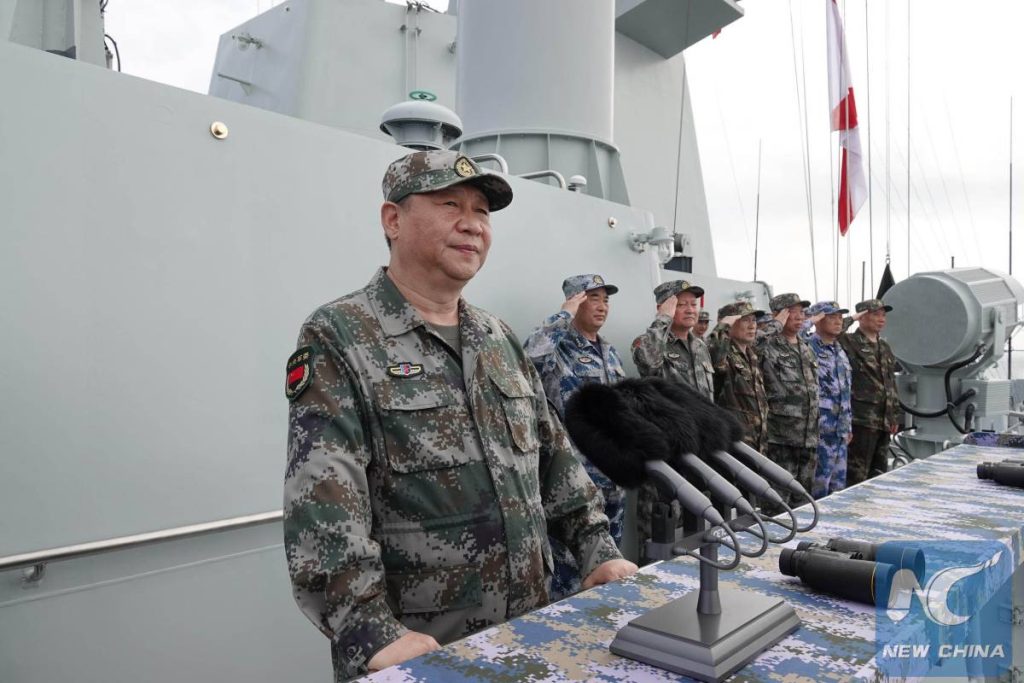China, set to complete its military expansion and modernisation by 2035 is all set to dominate the region with a range of lethal warships and submarines by 2031…reports Asian Lite News
China is “exponentially” increasing its warship capability and has reportedly re-started mass production of guided-missile destroyers.
The Chinese Communist party-controlled newspaper, the Global Times, reported on Tuesday that China would complete its military expansion and modernisation by 2035, “including the development of a blue-water navy, to match the country’s international status and better defend its interests”.
A blue-water navy is one that traverses deep oceans and operates globally.
Naval News has reported that five type 052D destroyers, capable of launching long-range missiles, are being built, The Guardian reported.
John Blaxland, professor of international security and intelligence studies at the Australian National University’s strategic and defence studies centre, said China’s military expansion was “deeply worrying”.
“When you look at capability it is growing exponentially,” he said.
“It’s going from being a brown-water navy designed for close protection of China’s shores to a true blue-water navy.
“They are designed to assert China’s influence to match its economic growth, not just in the South China Sea, not just in the first island chain [which includes Taiwan], but also more expansively through the Indo Pacific and the Pacific Ocean.
“It’s growing the navy to bolster its economic heft with military muscle.”
New modelling from a US thinktank suggests China’s People’s Liberation Army (PLA) will dominate the region with a range of lethal warships and submarines by 2031, The Guardian reported.
The Center for Strategic and Budgetary Assessments said in less than a decade, “the PLA may have sufficient resources to boast five aircraft carriers and over 60 cruisers and destroyers,” as well as a new fleet of submarines.
As part of the modelling, teams of national security experts used a simulation of China’s $300bn defence budget to predict what Beijing would do.
The consensus was that China would become a global military threat beyond the current sabre-rattling about Taiwan with enough resources for expanded sea and air capability, The Guardian reported.
Earlier a revised version of the US Congressional Research Service’s annual report, ‘China’s Navy Modernization: Implications for US Naval Capabilities’ has noted that China’s PLA Navy (PLAN) has been steadily modernizing since the mid-1990s, and has now become “a powerful military force” in the coastal waters.
The report tacitly calls for efforts to prepare for the challenge that this modernization poses, especially in the Western Pacific which has traditionally been an American bastion.
It categorically states that the Chinese navy is expanding its operations in more distant regions, with vessels entering waters near the Western Pacific, Indian Ocean, and Europe.
This assertion points to the fact that even though the US policymakers and military have made concerted efforts to counter China’s growing dominance in the seas far away from its territorial waters, it has achieved little success. India remains on the fringes while China has steadily moved to Europe and the Middle East with its Belt and Road Initiative.
The report further states that at a time when the United States Navy is achieving and maintaining dominance in the Western Pacific, the Chinese Navy’s advance is increasingly viewed as a challenge to that ability.
According to the study, this is the first time the US Navy has faced a situation since the Cold War. The Chinese navy is the most important aspect of China’s long-term goal to challenge American supremacy.
According to the research, the Chinese navy is the largest in East Asia. In terms of combat ship numbers, the Chinese navy overtook the US fleet a few years ago.
It is noteworthy that the United States has at least two major allies in the region, Japan and South Korea. It also has considerable influence among the ASEAN states that are in direct conflict with China in the South China Sea.
The US Department of Defense noted in the study, “The People’s Liberation Army Navy has roughly 355 vessels, including major maritime warships, submarines, aircraft carriers, amphibious ships, minesweepers, and other auxiliary ships. This figure excludes 85 patrol boats and combat platforms armed with anti-ship missiles.”
Some US analysts are concerned about the Chinese navy’s shipbuilding capabilities. According to the Pentagon, the number of ships with the PLA Navy is estimated to reach 420 by 2025 and 460 by 2030.
China is also set to soon launch its third indigenously developed aircraft carrier, which will bolster its capabilities in the sea with the advanced catapult-launch system. A fourth aircraft carrier, which is set to have nuclear capabilities, is also in the pipeline, according to South China Morning Post.

China’s naval modernization plans encompass a wide range of procurement programs for warships, aircraft, and weaponry, as well as improvements in maintenance and logistics, rules, personnel quality, education and training, and exercises.
According to the research, while the Chinese navy currently has some limitations and vulnerabilities, they are working hard to overcome them.
New ships have been launched at an alarming rate. Between 2014 and 2018, China launched more submarines, warships, amphibious vessels, and auxiliaries than the combined navy of Germany, India, Spain, and the United Kingdom.
